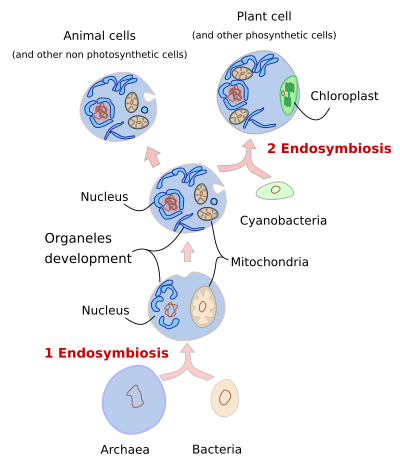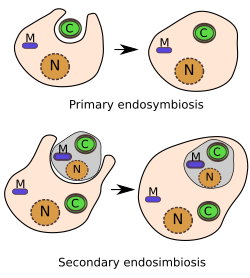It is thought that all living organisms have evolved from a cell type that appeared about 3500x106 years ago, known as LUCA (Last Universal Common Ancestor). This cell was simple and probably similar to current prokaryotes. However, the cellular complexity of some of these early cells increased with time, leading to the appearance of the eukaryotic cell. All current eukaryotic cells are believed to originate from one of these early cell lineages, which is referred to as LECA (Last Eukaryotic Common Ancestor). Nowadays, eukaryotic cells have internal membrane bound compartments such as the nucleus, endoplasmic reticulum, Golgi apparatus, endosomes, mitochondria, chloroplasts, as well as cytoskeleton. The oldest fossils found suggest that eukaryotic cells were already present about 1500x106 years ago, but it is plausible that eukaryotic cells appeared much earlier.
1. Definition
It is widely accepted that some organelles of eukaryotic cells emerged by endosymbiosis. Mereschokovsky (1905, 1910) was the first to propose that chloroplasts are the descendants of a prokaryotic cell incorporated by an ancestral eukaryotic cell. He named this process as symbiogenesis, which later led to the term endosymbiosis. Mitochondria were latter proposed to be also the result of an endosymbiosis process. The mitochondrial endosymbiosis occurred much earlier than the chloroplast endosymbiosis. Thus, both mitochondria and chloroplasts are derived from free ancient prokaryotic cells that were incorporated by other cells and evolved into intracellular organelles. Some authors have posed that peroxisomes, cilia and flagella were also originated by endosymbiosis processes, although there is little experimental support.
2. Evidences
The endosymbiosis theory is supported by some similarities between the current bacteria and the current mitochondria and chloroplasts. For example, both organelles have similar sizes than bacteria, circular strands of DNA inside, and 70S ribosomes. Furthermore, both organelles can proliferate independently inside the eukaryotic cytoplasm. The double membrane of mitochondria and chloroplasts are thought to come from the ancient bacterium, respectively, which only lost the peptidoglycan coat. These two organelles evolved from ancient free bacteria that got into other larger cells (mitochondria into an archaea and chloroplast into a eukaryotic cell). The two cellular types became so dependent from one another that they only could live together. The mitochondrial ancestors could be the ancestors of the current alfa-proteobacteria and the ancestors of chloroplasts could be the ancestors of the current cyanobacteria.
It has been suggested that the extraordinary cell complexity acquired by the eukaryote cells was a consequence of the large amount of energy supplied by mitochondria. However, some authors propose that the initial role of the mitochondrial ancestor was to produce heat, which allowed cells to live in cold environments, and that the production of ATP as an energy molecule may have appeared much later during evolution.
Chloroplasts and mitochondria are quite different from cyanobacteria and aerobic bacteria, respectively. For example, current cyanobacteria contain about 3000 genes, whereas the current chloroplasts only 100 to 200 genes. These chloroplastidial genes code for about 10 % of the chloroplast proteins. Thus, most of the ancient genes were transferred to the nuclear chromosomes and expressed under the control of the host cell. It is a very complex process because these genes need to be integrated and regulated in a new gene regulatory environment. Moreover, the proteins, which are synthesized in the cytosol, need to cross the chloroplast membranes and be targeted to particular places to carry out their functions. However, this complexity allows the host to control the function and proliferation of chloroplasts. A similar process happened during mitochondria evolution.
3. Process
The endosymbiosis theory proposes an initial fusion of two prokaryotic cells, most probably between a bacterium and an archaea (Figure 1). It likely happened after a long period of metabolic collaboration between both types of cells, so that there was a symbiosis (no endosymbiosis yet) before the fusion. Before, during, or after the fusion, the archaea developed a complex system of membranous organelles and a cytoskeleton, and the bacterium became the current mitochondria. Thus, we get a eukaryotic cell. Subsequently, there was a second endosymbiosis in some of these eukaryotic cells by prokaryotes containing chlorophyll, probably similar to the current cyanobacteria, which over the time become transformed into the current chloroplasts. These cells with two primary endosymbiosis developed into the photosynthetic cells of plants, algae and unicellular photosynthetic cells. That is, there have been two successive endosymbiosis, which is why some authors regard plant cells as well-organized microbial communities.

Currently, three primary endosymbiosis are known. Mitochondria and chloroplasts are the result of the two most widespread primary endosymbiosis. More recently, a third primary endosymbiosis involving an alpha-cyanobacterium and the eukaryote Paulinella chromatophora was found. In the three cases, the endosymbiont transferred genes to the host nucleus, or just lost genes, but kept those essential for proliferation and DNA processing. A secondary endosymbiosis (not to be confused with the second primary endosymbiosis) happened when a eukaryotic cell with mitochondria and chloroplasts engulfed another eukaryotic cell that also contained mitochondria and chloroplasts (Figure 2). The engulfed cell became endosymbiont, lost its nucleus or was atrophied, and its chloroplasts started to work for and depend on the host cell. Currently, three independent events of secondary endosymbiosis are known. Tertiary endosymbiosis happened when a eukaryotic cell incorporated another eukaryotic that was the result of a previous secondary endosymbiosis. There are living examples in nature of all these types of endosymbiosis.

Nowadays, there are many examples of bacteria, but none of archaea, living inside eukaryote cells as endosymbionts, even bacteria inside archaea. However, none of them have reached the level of integration schown by mitochondria and chloroplasts. All of them are examples of ways of cooperation between different cell types explored by evolution. For example, many invertebrates have bacteria that live inside the animal cells, and can complete their life cycle inside, and can even be transmitted to the offspring included within gametes. They are so well adapted that are harmless to the host, being sometimes beneficial or even essential. Actually, it is like an infection without significant collateral damages to the hosts, although they use the same molecular machinery as pathogenic bacteria for their proliferation. There are some examples of endosymbiosis involving two eukaryotes as well. For example, a paramecium (Bursaria) houses algae (Chlorella). Propelled by cilia, the paramecium always moves to illuminated places where algae take advantage of the high intensity of light to carry out photosynthesis, and the paramecium take advantage of the resulting products. There are many other examples. Some symbionts are called secondary and are not permanent. They produce horizontal invasions, that is, they can jump to a different host. In this case, their DNA is not as large as of free bacteria, nor as small as that of other more integrated endosymbionts.
-
Bibliography ↷
-
Bibliography
Dacks JB, Field MC. 2007.Evolution of the eukaryotic membrane-trafficking system: origin, tempo and mode. Journal of cell science. 120:2977-2985.
de Duve C. 1996. El origen de las células eucariotas. Investigación y Ciencia. Junio:18-26.
McFadden GI. 2001. Chloroplast origin and integration. Plant physiology. 125:50-53.
Poole AM, Penny D. 2006. Evaluating hypotheses for the origin of eukaryotes. BioEssays. 29:74-84.
Simpson AGB, Roger AJ. 2002. Eucaryotic evolution. Getting to the root of the problem. Current biology. 12:R691-R693.
-
 Origin of eukaryotes
Origin of eukaryotes 